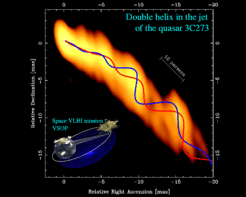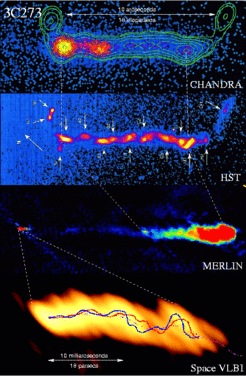A Double Helix in Outer Space

Studying the origin and development of plasma instability in extragalactic jets is crucial for understanding the nature of relativistic outflows from AGN. K-H instability is the most likely type of instability to be found in extragalactic jets. This instability originates from transverse velocity gradients or discontinuities due to interaction between the relativistic plasma of the outflow and (typically) sub-relativistic surrounding material. Recent theoretical works have predicted that K-H instability should produce complex, three-dimensional ribbonlike and threadlike patterns inside a relativistic jet. In these ribbons and threads, an order of magnitude increase of particle density and radio emissivity can be expected. In view of these findings, observational studies of internal structure of parsec-scale jets become particularly important for understanding the role of plasma instabilities in relativistic flows. Such studies require observations at extremely high angular resolution, which can be satisfied at present only by radio wavelength observations using very long baseline interferometry (VLBI).

In VLBI observations, signals from a celestial object are recorded simultaneously at a number of participating telescopes located worldwide. These signals are later combined together at one of the specially designed computer centers (correlators) which determine the correlations between the recordings from different telescopes. Further analysis of these correlations yields images with such an unprecedented resolution that could only be reached by a telescope with the diameter equal to the longest of the distances between the radio telescopes participating in the VLBI observation. For a typical observing wavelength of 6 centimeters, VLBI observations made with intercontinental arrays of radio telescopes reach a resolution of about 2 milliarcseconds. The space VLBI mission VSOP (VLBI Space Observatory Programme, led by the Japanese Institute of Space and Astronautical Science, has complemented ground VLBI arrays with an orbiting 8-meter antenna on board of the satellite HALCA. The VSOP observations provide 3-4 times better resolution, compared with ground VLBI observations at similar frequencies. For relatively close AGN, the resolution of the VSOP is sufficient for resolving the internal structure of their jets.
The quasar 3C273 is one of the closest, most luminous, and best studied AGN, with a prominent, relativistic outflow observed in the X-ray, optical and radio wavebands. The relativistic jet observed in the quasar 3C273 is one-sided, with no signs of emission on the counter-jet side at dynamic ranges of up to 16,000:1. This is evidence for strong relativistic boosting in an intrinsically double-sided outflow powered by an accretion disk around a central black hole. The structure and kinematics of such outflows are typically explained in terms of shock waves and Kelvin-Helmholtz instability.
3C273 was observed with the VSOP at the wavelength of 6 cm. The VSOP observation of 3C273 was supported by ten VLBA (Very Long Baseline Array, operated by National Radio Astronomy Observatory, USA) antennae and the Effelsberg 100-meter telescope operated by Max-Planck-Institut for Radioastronomy. To determine the interior structure of the jet, the MPIfR researchers have obtained and analyzed 240 profiles of brightness distribution across the jet. In most of the profiles, the presence of at least two distinct features is visible. The positions of these features form two continuous threads arranged in a spectacular double helical pattern, resembling indeed the familiar double helix of the DNA. To explain the presence of such a peculiar pattern in the jet, the MPIfR researchers have applied linear perturbation analysis of K-H instability, and successfully modelled the observed structure of the jet. Their model explains in detail the internal structure of the jet on scales of up to 30 milliarcseconds (~ 300 parsecs), accommodates the general morphology of the jet on scales of up to 100 milliarcseconds (~ 1 kiloparsec), and accounts for the observed periodic changes of the jet ejection angle. They conclude that the instability in the jet of 3C273 is developing in a plasma with moderate Lorentz factor and Mach number and a much lower density than that of the surrounding material. The calculated sound speeds agree with the values expected for a light, electron-positron jet plasma and a sub-relativistic ambient medium. Perhaps the most intriguing from this work is that the entire double helical pattern should move along the jet at a speed of about 0.2 speed of light. This prediction should be tested by future observations.

